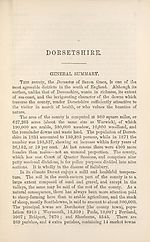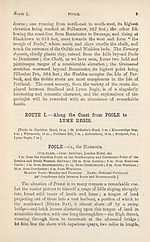Download files
Complete book:
Individual page:
Thumbnail gallery: Grid view | List view

4
GENERAL SUMMARY.
Route, 1.
and about 262 villages and hamlets. The county is represented
in Parliament by three members. Dorchester, Bridport, Poole
and Weymouth (with Melcombe Regis) return two each ; and Lyme
Regis, Shaftesbury, and Wareham (with Corfe Castle) one each.
Antiquities.—In Celtic and Roman Camps, in memorials of
the great struggle between invader and invaded, Dorsetshire is
peculiarly rich, as might be inferred from its natural configura¬
tion—its narrow defiles and bold abrupt downs offering defen¬
sive positions of considerable strength. If we knew more of the
history of the Roman conquest of Britain, we should doubtless
find it illustrated with many a deed of Celtic heroism, and be
able, • perhaps, to boast of many a British Thermopyhe. The
most noticeable entrenchments are those of Hod Hill, Hamildon,
Badbury Rings, Maiden Castle, Abbotsbury, and Nine Barrows.
Of the completeness of the Roman occupation of the county there
are also many proofs. Their great road—the Posse Way—ran
through Dorchester to the Land’s End, and at Dorchester exists
one of the most perfect amphitheatres in England.
The Churches of Dorsetshire are not remarkable for their
interest, with the exception of those at Wimbome Minster and
Sherborne.
Seats of the Gentry.—Kingston Lacy (D. Bankes, Esq.);
Canford Hall (Sir I. Bertie Guest, Baronet); St. Giles’ Park
(Earl of Shaftesbury) ; Lulworth Castle (Joseph Weld, Esq.');
Melbury Park (Earl of Ilchester); Critchill (Lord Alington);
Sherborne Castle (G. D. W. Digby, Esq.); Milton Abbey (Baron
Hambro) ; Bryanstone Park (Lord Portman).
Worthies of Dorsetshire.—Anthony Cooper, Earl of
Shaftesbury, a leading statesman in Charles IL’s reign, and his
grandson, the author of “The Characteristics,” were bom at St.
Giles’ Park, near Cranbome; Sir James Thornhill, the artist,
and father-in-law of Hogarth the painter, at Weymouth ; Admi¬
ral Sir Thomas Hardy, the captain of “the Victory” at Trafalgar,
was a native of Portisham ; Stilling fleet. Bishop of Worcester, and
author of the “ Origines,” bom at or near Cranborne ; Thomas
Sydenham, an eminent physician in the time of Charles II., at
Winford Eagle ; Captain Coram, founder of the Foundling Hos¬
pital, and Sir George Somers, the discoverer of the “ vext Be-
moothes” at Lyme Regis; and Bishop Poore, the architect of
Salisbury Cathedral, at Tarrant Crawford.
Geological Characteristics.—Two lofty ranges of chalk
GENERAL SUMMARY.
Route, 1.
and about 262 villages and hamlets. The county is represented
in Parliament by three members. Dorchester, Bridport, Poole
and Weymouth (with Melcombe Regis) return two each ; and Lyme
Regis, Shaftesbury, and Wareham (with Corfe Castle) one each.
Antiquities.—In Celtic and Roman Camps, in memorials of
the great struggle between invader and invaded, Dorsetshire is
peculiarly rich, as might be inferred from its natural configura¬
tion—its narrow defiles and bold abrupt downs offering defen¬
sive positions of considerable strength. If we knew more of the
history of the Roman conquest of Britain, we should doubtless
find it illustrated with many a deed of Celtic heroism, and be
able, • perhaps, to boast of many a British Thermopyhe. The
most noticeable entrenchments are those of Hod Hill, Hamildon,
Badbury Rings, Maiden Castle, Abbotsbury, and Nine Barrows.
Of the completeness of the Roman occupation of the county there
are also many proofs. Their great road—the Posse Way—ran
through Dorchester to the Land’s End, and at Dorchester exists
one of the most perfect amphitheatres in England.
The Churches of Dorsetshire are not remarkable for their
interest, with the exception of those at Wimbome Minster and
Sherborne.
Seats of the Gentry.—Kingston Lacy (D. Bankes, Esq.);
Canford Hall (Sir I. Bertie Guest, Baronet); St. Giles’ Park
(Earl of Shaftesbury) ; Lulworth Castle (Joseph Weld, Esq.');
Melbury Park (Earl of Ilchester); Critchill (Lord Alington);
Sherborne Castle (G. D. W. Digby, Esq.); Milton Abbey (Baron
Hambro) ; Bryanstone Park (Lord Portman).
Worthies of Dorsetshire.—Anthony Cooper, Earl of
Shaftesbury, a leading statesman in Charles IL’s reign, and his
grandson, the author of “The Characteristics,” were bom at St.
Giles’ Park, near Cranbome; Sir James Thornhill, the artist,
and father-in-law of Hogarth the painter, at Weymouth ; Admi¬
ral Sir Thomas Hardy, the captain of “the Victory” at Trafalgar,
was a native of Portisham ; Stilling fleet. Bishop of Worcester, and
author of the “ Origines,” bom at or near Cranborne ; Thomas
Sydenham, an eminent physician in the time of Charles II., at
Winford Eagle ; Captain Coram, founder of the Foundling Hos¬
pital, and Sir George Somers, the discoverer of the “ vext Be-
moothes” at Lyme Regis; and Bishop Poore, the architect of
Salisbury Cathedral, at Tarrant Crawford.
Geological Characteristics.—Two lofty ranges of chalk
Set display mode to:
![]() Universal Viewer |
Universal Viewer | ![]() Mirador |
Large image | Transcription
Mirador |
Large image | Transcription
| Antiquarian books of Scotland > Adventure and adventurers > Black's guide to the counties of Dorset, Devon, & Cornwall > (24) |
|---|
| Permanent URL | https://digital.nls.uk/142586666 |
|---|
| Description | Thousands of printed books from the Antiquarian Books of Scotland collection which dates from 1641 to the 1980s. The collection consists of 14,800 books which were published in Scotland or have a Scottish connection, e.g. through the author, printer or owner. Subjects covered include sport, education, diseases, adventure, occupations, Jacobites, politics and religion. Among the 29 languages represented are English, Gaelic, Italian, French, Russian and Swedish. |
|---|

